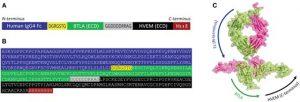Traditionally, monoclonal antibodies are created by immunizing animals with purified proteins. However, protein complexes are often unstable during this process, breaking apart before the immune system can generate antibodies that recognize the assembled structure. This instability has made it difficult to develop antibodies that detect or quantify protein complexes—even though these complexes are involved in nearly every biological function and are often altered in diseases like lupus and cancer.
Recently, scientists have discovered a way to overcome that hurdle. In a study they reveal a new technique: fusing protein complexes together to stabilize them during immunisation and a new generation of highly specific monoclonal antibodies (figure 1).

Figure 1: HVEM-BTLA-Fc fusion protein design. (A) Schematic diagram of peptide elements in HVEM-BTLA-Fc fusion protein. (B) The amino acid sequence of HVEM-BTLA-Fc fusion protein. (C) The figure shows the solvent-accessible surface of the HVEM-BTLA-Fc dimer.
To test their new strategy, the researchers focused on BTLA (B and T lymphocyte attenuator) and HVEM (herpesvirus entry mediator)—two proteins on the surface of immune cells. These proteins form a complex that modulates immune activity, and imbalances in the ratio of their free and complexed forms have been linked to diseases such as lupus and lymphoma.
To overcome the instability issue, the researchers engineered a fusion protein, physically linking BTLA and HVEM to mimic their natural complex. This added structural stability made it possible to generate monoclonal antibodies that specifically recognize the complex—not just the individual proteins. Using this fusion protein, the team immunized animals and screened the resulting antibodies to identify those that bound only to the BTLA-HVEM complex. One standout antibody was then used to analyse live immune cells, successfully measuring and distinguishing between freestanding BTLA, HVEM, and their complex across different cell types.
By using complex-specific antibodies, clinicians may eventually be able to detect subtle shifts in protein-protein interactions, monitor disease progression, or tailor immune-based therapies with greater precision. Beyond BTLA and HVEM, this fusion-protein strategy could be used to target other elusive protein complexes involved in a wide range of diseases—from autoimmune disorders to neurological conditions and cancer.
Despite the hundreds of FDA-approved monoclonal antibodies (mAbs) revolutionising the diagnosis and treatment of diseases like cancer, autoimmune disorders, and infectious diseases, scientists say we’ve only scratched the surface of what antibodies can do. A major barrier? The difficulty of generating antibodies that target protein complexes—groups of proteins that work together to carry out critical biological functions.
This innovative strategy may help usher in a new generation of precision diagnostics and therapies, driven by the ability to detect protein complexes that were previously out of reach.
Journal article: Atwell, S., et al., 2025. Quantitative detection of the HVEM-BTLA checkpoint receptor cis-complex in human lymphocytes. The Journal of Immunology.
Summary by Stefan Botha










